Part 32: Post Game Things we missed - Buildings (Part 1)
Things we missed - Buildings (Part 1)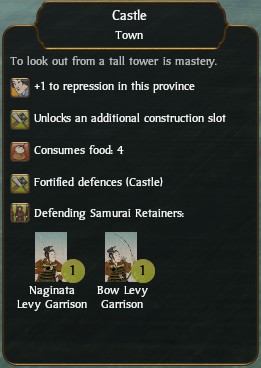
Cost: 5500
The Castle adds an additional concourse to the fortifications and strengthens the existing walls, making the province almost impossible to take by force! With additional arrow towers, even a small garrison will be exceptionally difficult to dislodge. It also increases the size of the garrison force in the province as well as the repression in the province. A Castle allows the construction of an additional building chain in the province. A Castle requires access to the Wood trade good.
Ingame encyclopaedia - Castle posted:
A castle is a sign of absolute ownership, stamped onto the landscape like a family seal, documenting power. It is a strong defence against enemy incursions, and a centre for administration within a province. With such an impressive structure looming over their homes, people feel secure, but they also understand that they must keep to their allotted stations in life. It also allows the province to develop further with new buildings. A castle was not only a military fixture in the life of a noble family, even though it was cunningly designed to make it as difficult to take as possible. It was also a celebration of their status and wealth. The effort of building and maintaining even one castle was almost crippling, so it became public statement of confidence, power and good taste. Beautiful craftsmanship and luxurious details made life in a castle anything but austere for the nobles. Such quiet ostentation also served to ram home the point that the owners were not to be trifled with, or ignored.
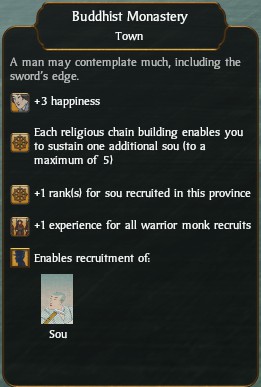

Cost: 3360/5850
The Buddhist Monastery is the third building in the Temple chain. It further increases province happiness and increases the rank of Sou produced in this province by one. It is required for the production of the Tetsubo Warrior Monk Hero in conjunction with a Koryu Dojo. The Famous Buddhist Temple is the last building in the Temple chain. It increases province happiness even more and further increases the rank of warrior monks produced in the province. It is required for the production of Naginata Warrior Monk Heroes, in addition to a Legendary Koryju Dojo. It requires the Incense trade good.
Ingame encyclopaedia - Buddhist Monastary posted:
The construction of a monastery is a tangible commitment to Buddhism, and it increases the happiness of all people in a province. As might be expected, a monastery is a place of quiet contemplation, removed from the worries of daily life. The monks are free to reach a better understanding of Buddha and his teachings, and to hone their skills as part of their contemplative exercises. In the 8th century, Buddhist monasteries were subject to significant interference from the imperial government. Regulations controlled all aspects of monastic life, and religious leaders found themselves acting as bureaucrats rather than contemplating their own spiritual development. Driven from the monasteries to escape such interference, the monks went out into the country and took the teachings of Buddha to the population as a whole. It was not long before new monasteries, free from Imperial and Court control, were founded. It was, however, useful for the monasteries to have patronage from the great families, and to offer religious respectability in return.
Ingame encyclopaedia - Famous Buddhist Temple posted:
A great temple serves as a focus for religious devotion and a place of pilgrimage. Its monks are men of enormous faith, entirely devoted to their work. At the heart of such a temple there is often a reliquary, a focus for pilgrims. More usefully, for the temple's noble sponsors, are the training halls and scholastic facilities that produce learned and enthusiastic monks, eager to spread the word. The building style of the earliest Buddhist temples was not particularly Japanese, as they copied Chinese and Korean patterns. Over time these changed to become more distinctively Japanese to cope with the local climate, and to withstand earthquakes. There was also less distinction than might be expected between Buddhist and Shinto buildings. It was not unusual to find that Buddhist temples included Shinto shrines within them, so that the local kami would not be disturbed. Likewise, larger Shinto shrines would have Buddhist temples somewhere within the shrine complex. It was only after the Meiji Restoration in 1868 that a stricter division was introduced into Japanese religious life.
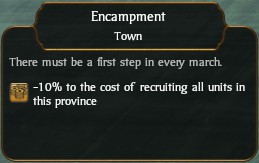
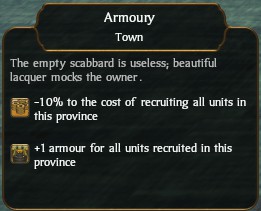
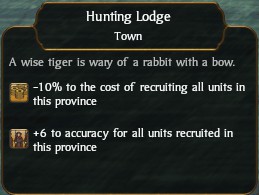
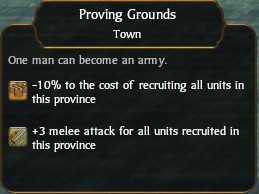
Cost: 765/1600/1600/1600
The Encampment reduces the cost of all land units recruited in this province. It can be upgraded into one of three possible buildings - Armoury, Hunting Lodge and Proving Grounds. The Armoury increases the armour of all units produced in this province. The Hunting Lodge increases the accuracy of all ranged units produced in the province. The Proving Grounds increases the melee attack of all units produced in this province.
Ingame encyclopaedia - Encampment posted:
All armies need to have somewhere for new recruits to gather and do at least a little training. An encampment can be as simple as a line of tents or have the air of a semi-permanent military town, but it has one purpose: to turn undisciplined and scared civilians into something resembling soldiers. Having one makes it easier and cheaper to recruit units, and to send casualty replacements where they are needed. Encampments have always allowed commanders to keep their men where they can be watched. Given half a chance, civilians will do their best to separate young men from their money with drink, women and gambling. All of these can cause trouble in the military, particularly as soldiers are often happy to indulge in such pleasurable alternatives to drill and training. Encampments have to be well organised, otherwise illness could sweep through them, and this gives a practical reason for learning the disciplines of a soldierly life. A man who has dug latrines for a few hundred of his comrades is likely to see battle as a pleasant alternative!
Ingame encyclopaedia - Armoury posted:
An armoury centralises the supply of arms and armour, and guarantees that all equipment will be of a given quality. It is not just a store, but usually includes workshops for craftsmen to repair and create military items. It therefore improves the defensive strength of any unit recruited in the same province. Nearly all armies of the medieval period relied on looting the dead to provide weapons and equipment for the living. Sometimes this was even an organised business. This, however, was discovered by many to be a ramshackle way to run a war. By centralising armour under the control of noble families, they could also introduce a level of uniformity into their armies. A medieval European army would be a riot of colours, liveries and heraldry, while a Japanese army would have a calm uniformity to it. This has a practical benefit for a warrior: anyone not wearing the same armour as you in a battle is almost certainly an enemy!
Ingame encyclopaedia - Hunting Lodge posted:
Hunting teaches men to fire accurately and quickly against swift-moving targets. To miss is to go hungry or be eaten by something inedible! Therefore, a hunting lodge improves the firing accuracy of missile-armed troops recruited in this province. Archery has always been about food as well as warfare. An arrow does care whether it strikes a deer or a man. Shooting and stalking skills honed in providing food always transfer to a martial context. The hunter who misses with his first shot usually never gets the chance to take a second one. Despite their poetic names, the narrow willow-leaf, willow-leaf and dragon's tongue were all lethally sharp arrow heads designed to kill the target by causing massive bleeding. Anything hit by one of these would soon bleed to death. On the other hand, archers used the blunt, turnip-shaped whistling signal arrows against their targets when dog hunting. This, presumably, allowed them to make it more of a "sport" as each dog would require several hits before it was disabled or killed.
Ingame encyclopaedia - Proving Grounds posted:
These proving grounds will improve the attacking strength of any unit trained in the province. An army is more than a collection of individuals, no matter how personally brave they may be. It needs discipline, good order and confidence in its tactics and commanders if it is to work to full effect. This includes an understanding of exactly how its weapons are best used in action. When a unit fights as one, not as a mob, using its weapons properly, its strength is magnified and fully utilised. Every soldier needs to understand and trust in the weapons he carries. This is why drill has always been an important part of training. A soldier becomes completely familiar with what he is supposed to be doing, without even the need for conscious thought. He also comes to grasp the full potential of the weapons he has been given by his commanders. Practice does pay off in combat: men trained to fight together will always be better than a mass of individuals each seeking their own petty glory.
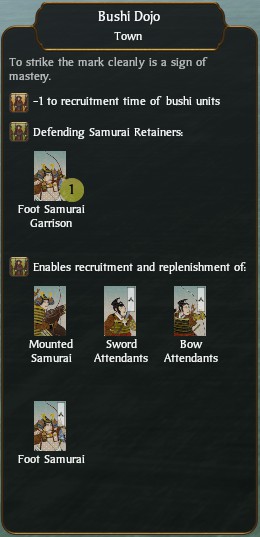
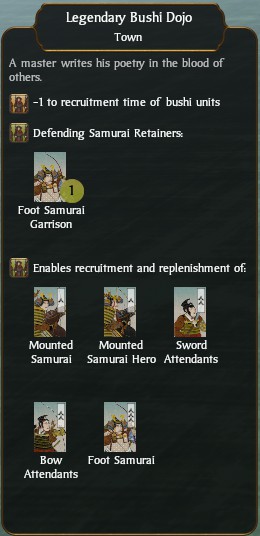
Cost: 3200/6800
The Bushi Dojo adds a regiment of Foot Samurai garrison, reduces the recruitment time of all Bushi units by 1 turn and allows the production of Mounted Samurai with a Pastures. It also increases the experience of Bow Attendants, Sword Attendants and Foot Samurai produced there. The Legendary Bushi Dojo allows the recruitment of Mounted Samurai Heroes with a Pastures. It also increases the rank of all units produced here by a further 1 (Hero units included), with the exception of Foot Samurai, which it increases by 2. You may only have one Legendary Bushi Dojo and it requires access to the Iron trade good.
Ingame encyclopaedia - Bushi Dojo posted:
Nearly every warrior culture on the Eurasian landmass defined its warrior elite as fighters on horseback. The word for "cavalryman" is often synonymous with a ruling, higher social caste within a society. They quite literally look down on the peasants. This is not surprising: apart from anything else, the expense of buying and owning a horse meant than anyone who had a warhorse was, by definition, an important man in the community. The samurai began as mounted warriors. As a child, a samurai was put in the saddle almost as soon as he could walk. His weapons training emphasised battle from horseback, although the earliest samurai fought as mounted bowmen, using their horses to move swiftly away from any threat before returning to harass their enemies once again. Early samurai armour, for example, is perfect for this fighting style; it will keep out arrows rather effectively, but not sword cuts.
Ingame encyclopaedia - Legendary Bushi Dojo posted:
Samurai warfare was, at least initially, an affair of individuals who acted independently on the battlefield. Men would advance towards their enemies, calling out their names and achievements in the hopes of finding a worthy opponent to fight. This kind of affair is not so much a battle as a massive series of duels between brave men. A warrior tagged the head of his slain enemy, and these were displayed after the battle to determine each man's contribution to victory. It was, by the way, a very bad idea to take the head of a friend in the confusion of battle. However, the idea of individual heroism is a powerful one, and one that the way of the warrior embodied in many ways. Every warrior on the battlefield would regard a truly heroic warrior, even an enemy, with admiration.
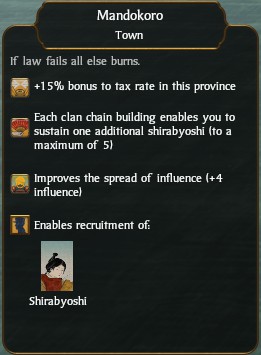
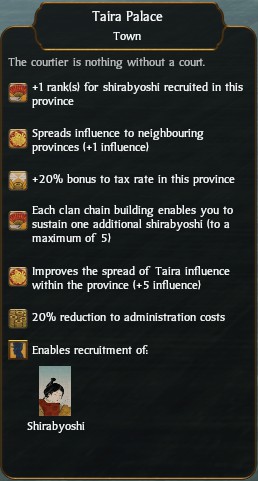
Cost: 3600/6800
The third building of the Estate chain, the Mandokoro, increases the province tax rate by another 5%, as well as further increasing the clan support. The final building, the Taira Palace, adds an additional 5% tax rate for the province, even further increases clan support, spreads clan support to neighbouring provinces, increases the rank of Shirabyoshi recruited here and reduces your overall clan administration cost by 20%. It requires the Silk trade good.
Ingame encyclopaedia - Mandokoro posted:
Law and order are important in any stratified and authoritarian society. Everyone has to know their place in the system, and the penalties for transgression. It is a practical solution to the problem of having many people live in a relatively small space, if not very attractive to those at the bottom of the social heap. In this, Japan was no different to many other parts of the world in the medieval period. "Social mobility" or moving from one social class to another was almost completely unknown. A man would be born, live and die a samurai, peasant or townsman. He could fall into poverty as a samurai and be unable to earn a living because it was socially beneath him, or rise to tremendous riches as a townsman, and remain lower in the social pecking order than the humblest peasant. The law, however, existed to protect those who behaved themselves and stayed within the bounds of acceptability.
Ingame encyclopaedia - Taira Palace posted:
This palace increases Taira family influence immensely. It also improves tax collection, and gradually converts the people of neighbouring provinces into supporters of the Taira, if only because of its overwhelming grandeur. Additionally, shirabyoshi trained in this province are more experienced, simply because they have such a demanding Taira audience to satisfy at the palace. Historically, the Gempei War ended disastrously for the Taira family. Arrogance, understandable perhaps, and excessive ambition eventually brought a reaction from the other great families. The Taira were usually outmatched in battle, even with the person of the Emperor to inspire their warriors. Eventually, most of the Taira drowned at the Battle of Dan-no-ura; those who were aboard ships not sunk by enemy action threw themselves into the sea, along with the six-year-old Emperor Antoku. The Taira also attempted to throw the Imperial regalia into the deeps, and may even have done so with the sword and the mirror, although these may have been ceremonial copies rather than the originals given that the regalia is still in use today. The remaining Taira were executed.

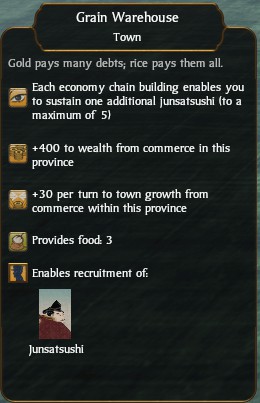
Cost: 3000/7500
The third building in the Granary chain, the Granary further increases the town growth in the province as well as providing an additional food. The final building, Grain Warehouse, further increases town wealth, even further increases town growth and provides yet another additional food. It requires the Crafts trade good.
Ingame encyclopaedia - Granary posted:
Food storage until the next harvest is very important to the functioning of any community. If no one can think beyond where their next meal might come from, there is no incentive to do very much other than look for that next meal. Once there is a reasonable degree of certainty that people will be able to eat tomorrow, the next day, next week and beyond, they can start planning for a future, and working towards it. It becomes worthwhile to improve your land, build a new workshop, or learn a new skill: you will live long enough to see the benefits of your efforts!
Ingame encyclopaedia - Grain Warehouse posted:
Better food storage means that fewer people starve, and that more survive the lean years when they inevitably come. It is also possible to create enough of a food surplus so that it can be traded, bringing wealth into the province and making people's lives better in that way. Once a community has the spare time and capacity over and above feeding itself, creativity and hard work can bring further rewards, other than just living for a few more hungry years!
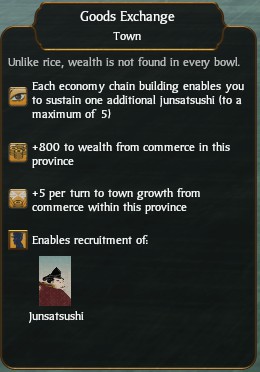
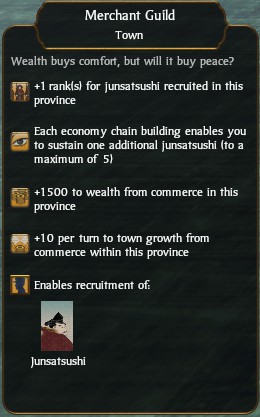
Cost: 3300/7600
The third building in the Market chain, the Goods Exchange provides an even more substantial boost to the town wealth in the province. The final building, the Merchant Guild, provides an absolutely enormous boost to town wealth, further increases the town growth and improves the skill of Junsatsushi's recruited here. It requires the Crafts trade good.
Ingame encyclopaedia - Goods Exchange posted:
A goods exchange adds significantly to a province's wealth. Merchants, traders and craftsmen can specialise, and buy or produce in bulk making their wares more profitable. It is the ability to specialise and find a market for your works that allows great craftsmen to flourish. A single very rich patron can create his own personal market for craftsmen, of course, but a marketplace with many customers is more profitable and stable in the long run. After all, the death of a lordly patron means the money and trade he created disappears. It takes a significant disaster to wipe out a complete province full of customers! Market forces in the form of the natural aspirations of people to want better, nicer things soon bring wealth.
Ingame encyclopaedia - Merchant Guild posted:
A merchants' guild adds to the amount of wealth in a province. By forming a guild, the merchants gain control of trade with other provinces, and have a cosy cartel that fills their purses at the expense of others. This wealth can then be taxed by its overlords. After all, it is fair that the merchants, with so much to protect, should end up paying a substantial amount for their safety. Guilds were often granted trade concessions in return for knowing their place in the scheme of things, and paying their taxes promptly. While merchants could become extremely rich, socially they were regarded as being lower than humble peasants: they did not labour honestly in the fields to feed people, but somehow made money in unnamed, but undoubtedly unsavoury, ways. It was, of course, completely beneath any warrior to actually work for a living, so merchants and other townsfolk remained an unfortunate necessity.
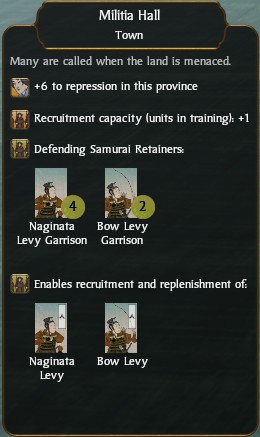
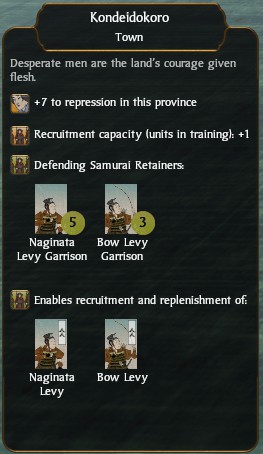
Cost: 2520/4200
The third building in the watch chain, Militia Hall, adds an additional Bow Levy and Naginata Levy to the garrison of the province, as well as boosting repression. It also increases the experience of levy units recruited in this province. The final building, the Kondeidokoro, boosts repression even further, adding yet another Bow Levy and Naginata Levy to the garrison, as well as adding a further rank of experience to Levy units produced here.
Ingame encyclopaedia - Militia Hall posted:
A militia hall adds to the repression of the local people by reminding them that the military power of their overlords is all around them. It also acts as a gathering place for local defence forces, when they are needed as invaders approach. By having locals defend their own homes when his officers decide it is necessary, a warlord can also make sure that weapons only get into the hands of men who are regarded as trustworthy or, at worst, are not actively hostile to his rule. Those who are disloyal will have to face any invaders alone, and armed only with whatever implements they can find on their farms. This alone can influence the behaviour of troublemakers, because who wishes to risk his wife and children dying because they cannot be defended?
Ingame encyclopaedia - Kondeidokoro posted:
The kondeidokoro fulfils two functions. Firstly, it acts as a military post, a rallying point for the many local militia who can be called into service to defend their home province. Secondly, it is a clear sign to all that the local lord and his agents are watching, all the time, and it significantly increases repression in a province. The need for people to behave themselves was always paramount in Japan: there simply wasn't the room for troublemakers, or the opportunity to send them abroad to cause trouble for someone else. This had been the European solution: open up new lands, or invade someone. At the time of the Gempei War neither plan was an option for the Japanese, as almost every usable bit of land in Japan was already being used for something, and the nearest neighbours were China and Korea. A rigid social system was therefore a practical solution to having so many people needing to live together.
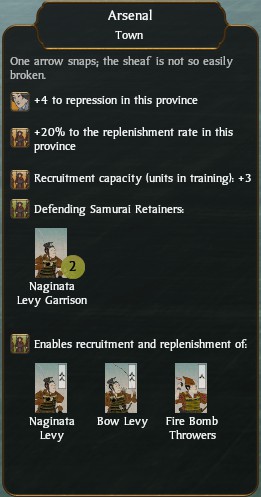
Cost: 4500
The Arsenal provides an enormous boost to replenishment in the province, in addition to providing another recruitment slot, bringing the total number of units recruit-able a turn to 3. It also increases the experience of all levy units produced in the province by another 1.
Ingame encyclopaedia - Arsenal posted:
An arsenal also adds greatly to the organisation and efficiency of military activities in the province. Men can be swiftly equipped and allocated to new units, or sent as replacements to understrength forces. The arsenal also houses specialist smiths, weapon workshops and stores. The various demonic mixtures needed to make firebombs can be stored here, and men trained in their safe handling, if the word "safe" can ever be applied to such hellish devices! An arsenal is often a substantial investment for any warlord, if only for the enormous quantities of armour and weapons stored there. It does, however, significantly increase military power by allowing armies to be raised quickly and easily.

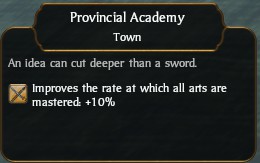
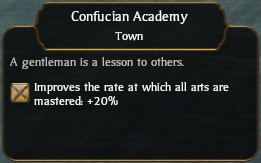
Cost: 2070/3360/5600
The Calligraphy School further increases the bonus to arts. The Provincial Academy continues to improve the bonus to arts. It requires the Chinese Texts trade good. The Confucian Academy provides an enormous boost to arts, but only a single such building can be constructed in your empire. It also requires the Chinese Texts trade good.
Ingame encyclopaedia - Calligraphy School posted:
Written records are important for both for government purposes and for intellectual pursuits. Without books, ideas are lost as men die; an idea written down has more power than any sword. A calligraphy school creates the scribes that are needed to record everything that occurs in a lord's domain. Thinkers need to record their thoughts, and these can then be widely promulgated. Fine calligraphy is one of the arts that Japan has made its own. A written language that is based on ideograms rather than an alphabet almost demands that scribes produce beautiful texts just as artistic achievements. The act of writing became an act of meditation, and the artistic sincerity and beauty of the finished product only added to the meaning of a document. The recipient of a message could easily be swayed by the perfection of the calligraphy, as much as by what the document actually said. It was respectful to the reader, not to mention honourable, for the writer to put his heart and soul into his skilled calligraphy.
Ingame encyclopaedia - Provincial Academy posted:
By gathering the very best scholars together in one place, a provincial academy becomes a power-house for new ideas and for reviewing age-old wisdom. The challenging of older ideas may not always be encouraged, but in such an atmosphere of learning, development of the arts proceeds apace. The ideas of Confucius (551 - 478BC) were hugely influential across Asia, including Japan. Confucius valued education as a way of bettering people and society, and his ideas encouraged a meritocratic approach to education. Those who could learn should learn as far Confucian philosophy was concerned. At the same time, the growth of Japanese Imperial influence required more courtiers and administrators: these men had to be educated to a high standard if they were going to be capable of doing their jobs. A strong man with a good sword arm was not enough to run a province properly.
Ingame encyclopaedia - Confucian Academy posted:
A Confucian academy aims to improve its students by teaching a philosophical system that embraces political, ethical, moral, and even religious elements. The teachings of Confucius give the students a deep understanding of the world, and greatly aid the development of the arts in the process. The Chinese philosopher Confucius (551-478 BC) is one of the most influential figures in world history. Confucian teachings are, at heart, optimistic and humane, holding that men can be taught and made better by their own efforts. There is an emphasis on honesty and righteousness, at all levels of society, and towards all others in society. Confucianism holds that a ruler should act correctly towards his subjects; in turn the social elite were expected to behave with benevolence and to set a good example for the rest of society. It is not particularly egalitarian, but then such an idea would probably have been inconceivable at the time. Confucianism did, however, have an appeal across much of Asia, including Japan; its emphasis on righteousness and honesty meshed with much of the best elements of the samurai ethos in bushido.


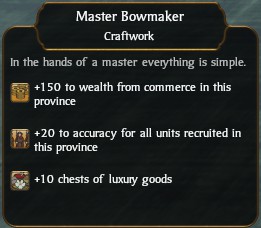
Cost: Free/1350/4500
The first building in the Craftwork province speciality, Artisans increases the town wealth, accuracy of units produced in this province and produces the Crafts trade good. It can be upgraded into the Washi Mills or Bowmaker buildings. The Bowmaker further increases the accuracy of units produced in this province. The final building, Master Bowmaker, even further increases the accuracy of units produced in this province.
Ingame encyclopaedia - Artisans/Fletcher/Master Bowmaker posted:
By investing in artisans it is possible to help the economy grow steadily or to improve the accuracy of archers. Craftsmen add to the quality of life for all the people. Everyone, from the simplest peasant to the mightiest warlord, can appreciate good workmanship when he sees and uses a well-made object.
Craftsmanship of all kinds has always been admired in Japan. A calligrapher who produces the perfect brush stroke to write a scroll, and a potter who makes a perfect bowl are valued. What is required from all of these men and women is absolute dedication to their craft and, eventually, the ability to make the remarkably difficult seem effortless. Such work never is; technique has demanded dedication. Today the Japanese government recognises great craftsmen as ningen kokuho "living national treasures" or, more properly, juyo mukei bunkazai hojisha which translates as "preservers of important intangible cultural properties". Behind this bureaucratic language is a remarkable and worthy idea: to preserve the best by honouring these highly skilled people.

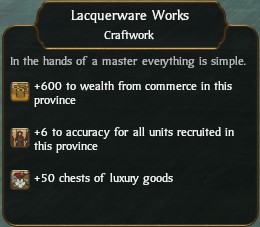
Cost: Free/3750
The first building in the Craftwork province speciality, Artisans increases the town wealth, accuracy of units produced in this province and produces the Crafts trade good. It can be upgraded into the Washi Mills or Bowmaker buildings. The final building, Lacquerware Works, even further increases the town wealth and massively increases the number of Craft trade goods produced.
Ingame encyclopaedia - Artisans/Washi Mills/Lacquerware Works posted:
By investing in artisans it is possible to help the economy grow steadily or to improve the accuracy of archers. Craftsmen add to the quality of life for all the people. Everyone, from the simplest peasant to the mightiest warlord, can appreciate good workmanship when he sees and uses a well-made object.
Craftsmanship of all kinds has always been admired in Japan. A calligrapher who produces the perfect brush stroke to write a scroll, and a potter who makes a perfect bowl are valued. What is required from all of these men and women is absolute dedication to their craft and, eventually, the ability to make the remarkably difficult seem effortless. Such work never is; technique has demanded dedication. Today the Japanese government recognises great craftsmen as ningen kokuho "living national treasures" or, more properly, juyo mukei bunkazai hojisha which translates as "preservers of important intangible cultural properties". Behind this bureaucratic language is a remarkable and worthy idea: to preserve the best by honouring these highly skilled people.

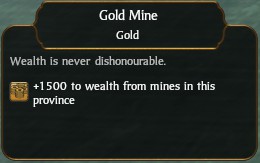
Cost: 2400/5000
Gold Lodes increases the province wealth by a greater amount than Placer Gold Mining. Gold Mine increases the province wealth by an even greater amount.
Ingame encyclopaedia - Placer Gold Mining/Gold Lodes/Gold Mine posted:
There is gold in this province and it is easily worked thanks to surface deposits. However, by investing in bigger and deeper mines, it is possible to greatly increase the wealth generated by this province. Gold is, of course, always welcome to any warlord because all wise commanders know that wars cannot be fought, let alone won, without wealth. Gold mining is a dirty and dangerous business for the miners and surface workers. Their lives are likely to be short and brutal, and woe betide anyone who even thinks about stealing the wealth lying all around!